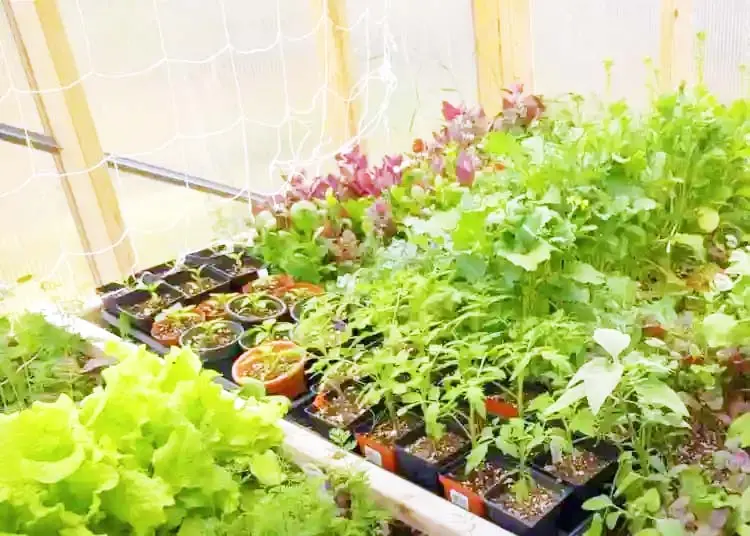Lately, I’ve come across a lot of people intrigued by greenhouse gardening, pondering over this very question.
What is the easiest thing to grow in a greenhouse?
Herbs such as basil, mint, and parsley are among the easiest plants to grow in a greenhouse. Their compact size, low maintenance needs, and relatively quick growth make them ideal candidates for greenhouse cultivation.

Why Choose Herbs for Your Greenhouse?
- Herbs are Beginner-Friendly
- Herbs are beginner-friendly: They require minimal care and attention, making them perfect for novice greenhouse gardeners.
- Even gardeners with limited experience can successfully grow herbs with minimal effort, fostering confidence and enthusiasm for further greenhouse endeavors.
- Fast Growth
- Herbs tend to grow quickly, allowing for regular harvests and a steady supply of fresh ingredients.
- This swift growth cycle allows for frequent harvesting, ensuring a constant supply of fresh herbs for culinary use.
- Compact Size
- Most herbs have a small footprint, making them suitable for even the smallest greenhouse setups.
- Whether you have a sprawling greenhouse or a compact setup, herbs can thrive in containers or small plots, maximizing your greenhouse’s potential.
- Versatility:
- Herbs like basil, cilantro, and thyme can be used in various culinary dishes, adding flavor and aroma to your meals.
- From classic staples like basil and parsley to exotic varieties like lemongrass and Thai basil, herbs offer endless possibilities for culinary experimentation and creativity.
- Cost-effective:
- Cultivating herbs in your greenhouse can yield substantial cost savings over time, particularly if you frequently incorporate them into your cooking.
- By bypassing the need to purchase expensive store-bought herbs, you can enjoy a bountiful supply of fresh, organic herbs at a fraction of the cost, ultimately reducing your grocery expenses.
Tips for Growing Herbs in Your Greenhouse
- Choose the Right Varieties:
- Select herb varieties that thrive in greenhouse conditions and suit your culinary preferences.
- Consider the specific requirements and characteristics of different herb varieties when selecting which ones to grow in your greenhouse.
- Opt for herbs known to thrive in greenhouse conditions, such as basil, chives, and mint, to ensure successful cultivation.
- Tailor your choices to suit your culinary preferences and usage, prioritizing herbs that you frequently incorporate into your cooking for maximum utility and enjoyment.
- Provide Adequate Light:
- Herbs require ample sunlight to grow, so ensure your greenhouse receives sufficient natural light or supplement with artificial grow lights if needed.
- Position your greenhouse in a location that receives ample sunlight throughout the day to support healthy herb growth.
- Monitor light levels regularly and adjust placement or lighting setups as needed to maintain optimal conditions for photosynthesis and overall plant health.
- Monitor Watering Needs:
- Develop a watering routine based on the specific moisture requirements of your herb plants and the moisture retention properties of your greenhouse soil.
- Avoid overwatering, which can lead to root rot and fungal diseases, by allowing the soil to partially dry out between waterings.
- Use a moisture meter or conduct regular soil checks to assess moisture levels and adjust watering frequency accordingly, aiming for consistently moist but not waterlogged soil.
- Maintain Proper Ventilation:
- Install vents, louvers, or fans in your greenhouse to facilitate air circulation and prevent stagnant air and humidity buildup.
- Proper ventilation helps regulate temperature, reduce disease incidence, and promote overall plant vigor and productivity.
- Monitor airflow patterns within your greenhouse and adjust ventilation settings as needed to ensure optimal conditions for herb growth and development.
- Control Temperature and Humidity:
- Install a thermometer and hygrometer to monitor temperature and humidity levels within your greenhouse accurately.
- Maintain temperatures within the preferred range of 60-70°F (15-21°C) for most herbs, adjusting heating or cooling systems as necessary to prevent temperature extremes.
- Use humidity trays, misting systems, or greenhouse humidifiers to regulate humidity levels and create a suitable microclimate for herb cultivation, especially during periods of low humidity or dry weather.
- Prune Regularly:
- Practice regular pruning and trimming to control the growth habit of your herb plants, encourage bushy growth, and prevent them from becoming leggy or overcrowded.
- Remove dead or yellowing leaves, spent flowers, and excess growth to maintain plant health and appearance.
- Pruning also stimulates new growth and enhances the overall aesthetic appeal of your herb garden, promoting a tidy and productive growing environment.
- Harvest Thoughtfully:
- Harvest herbs regularly to promote continuous growth and prevent plants from bolting or becoming overly mature.
- Use sharp scissors or pruning shears to make clean cuts, minimizing damage to the plant and reducing the risk of disease transmission.
- Harvest herbs early in the day when their essential oils are most concentrated for optimal flavor and aroma, and avoid harvesting more than one-third of the plant’s foliage at a time to ensure continued vitality and productivity.
By following these guidelines and implementing best practices for greenhouse herb cultivation, you can create an optimal growing environment that maximizes yield, flavor, and overall plant health, allowing you to enjoy a bountiful harvest of fresh, aromatic herbs year-round.
Conclusion:
In conclusion, when it comes to greenhouse gardening, herbs stand out as the easiest and most rewarding option for both beginners and experienced gardeners alike. With their simplicity, versatility, and culinary appeal, herbs can transform your greenhouse into a thriving oasis of flavor and fragrance. So why wait? Start your herb garden today and reap the bountiful rewards of greenhouse cultivation.
- What is the easiest thing to grow in a greenhouse? - August 17, 2023